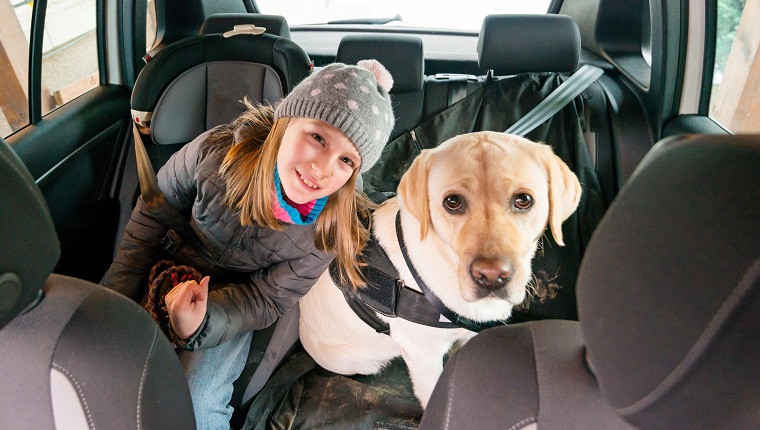We all have to transport our dogs in the car at times. We might be going to the vet or the groomer, or just taking them along for the ride.
Most dogs go wild at the jingle of the car keys or when they hear, “Wanna go for a ride?” Riding in the car is a treat, and another opportunity for us to spend time with our dogs.
More than half of the millions of dog parents in the United States claim that they drive with their dogs in the car at least once a month. That’s a lot of dogs riding in cars!
When you take your human family members for a drive, you probably make sure they buckle up for safety. However, far fewer drivers think about the safety of their furry family members.
If you plan to take your dog for a drive, consider equipping your vehicle with a dog seat belt, and buckle your dog in the back seat, rather than letting them ride shotgun. Here are a few things you should know about dog seat belts and car safety, and why they’re so important.
A Dog Without A Seat Belt: What Could Go Wrong?

Many unrestrained dogs love the shotgun and front seat areas because they are near their favorite humans. They can also stick their heads out the window to get that wonderful breeze that dogs love so much.
However, an unrestrained pet in a moving car is always in danger. Dogs can be thrown out the window or through the windshield if you stop suddenly or have an accident.
Airbags are an issue as well. Most pop out with enough force to severely injure and, in some cases, kill a dog.
Allowing your dog to ride in the front seat also means they can interfere with your driving. Some dogs love climbing into your lap when you’re driving. Others climb down onto the floor where they can get in the way of the gas pedal or brake.
Did you know that looking away from the road for only two seconds doubles your risk of an accident? According to a survey conducted by AAA and Kurgo the most common distraction our dogs provide in the car is that we tend to take our hands off the steering wheel to pet them. That’s a big problem.
“An unrestrained 10-pound dog in a crash at only 30 mph will exert roughly 300 pounds of pressure, while an unrestrained 80-pound dog in a crash at only 30 mph will exert approximately 2,400 pounds of pressure. Imagine the devastation that can cause to your pet and anyone in its path,” says Huebner-Davidson, AAA National Traffic Safety Programs manager.
This is why it’s so important to restrain your dog while driving.
Many dog parents claim they know about dog seat belts and harnesses but don’t use them because their dogs are “mellow.” It’s important to note that a mellow dog can fly out of a car window just the same as a hyper dog in the event of an accident.
Are Dog Seat Belts Safe & Effective?
The safest way to ride with your pet in the car is to get a pet seatbelt or restraint, but research your options before selecting a brand.
Until somewhat recently, there has been no independent safety testing of car harnesses for dogs, and buyers had to rely on the manufacturers’ claims.
That has changed since the independent non-profit Center for Pet Safety did crash tests under the same conditions that the Federal Motor Vehicle Safety Standard established for child safety seats.
Their results: it was a bumpy ride for some brands, with only seven making it through the initial crash test without catastrophic failure.
Most of these dog safety belt manufacturers aren’t big corporations, but small companies whose owners really do care about dogs. After independent testing, some of these companies were proactive.
They re-engineered their safety belts and harnesses to help them perform better.
What Did The Crash Safety Tests Show?
After the test in 2013, the top-rated harness was the ClickIt Utility made by Sleepypod. The second-ranked dog safety restraint was the AllSafe, made by a German company called Kleinmetall.
Since these tests, many other companies have made safer dog seat belts. Take a look around and read online reviews before you purchase them. You can even ask your veterinarian for recommendations.
Most dogs aren’t going to be thrilled when you buckle then in the first time. However, they’ll get used to it, and it will become habit. Once a dog gets used to being buckled in, they’ll sit patiently as you gear them up for a drive, just like some do for a walk.
They should also sit in the back seat where the airbag can’t harm them. Shotgun is not the safest way for dogs to ride in the car, seat belt or not.
This should go without saying: allowing unrestrained dogs to ride in the back of pick-up trucks is a recipe for disaster. Not only will a sudden stop cause serious injury, but they could also easily jump out into traffic and be killed by another vehicle or cause a bigger accident. Never ever do this, no matter what.
Bottom line: use common sense and take steps to protect your canine cargo when it’s time to hit the road. It’s better to be safe than sorry!
Does your dog wear a seat belt for car rides? Do you think it’s a necessary safety precaution? Let us know in the comments below!









